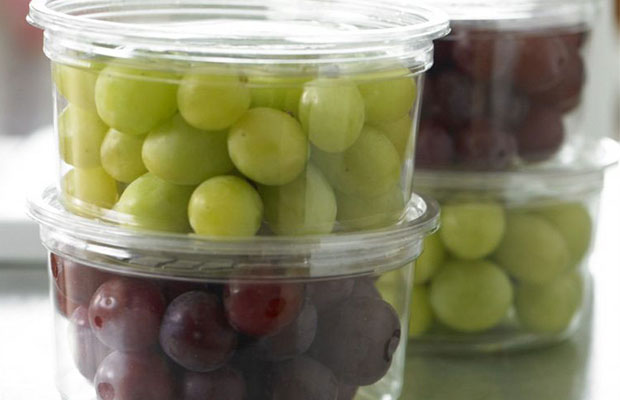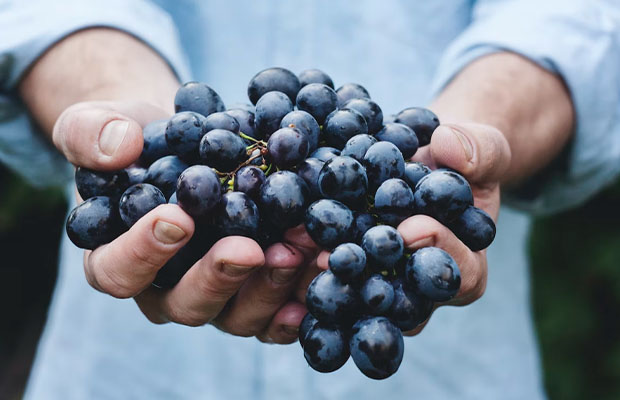For the product to stay fresh, understanding how to store grapes is essential. If you frequently consume grapes, it’s helpful to understand how to create the best food storage environments when bringing them home from the supermarket or farmer’s market.
Do grapes need to be refrigerated? As soon as possible after harvest, grapes should be stored in the refrigerator. You can put them in the back of your crisper drawer since it’s typically the coldest place in the refrigerator because they thrive there at about 30-32 degrees Fahrenheit and 90-95 percent humidity.
Learn more about grape storage advice by reading on.
More Food Storage Posts:
Table of Contents
What Are Grapes?
Grapes are true berries from the Vitis genus of the Vitaceae family that grow in clusters on grapevines. These tiny, oval fruits have been produced for thousands of years and primarily consist of skin, flesh, and seeds. They grow on grapevines that naturally produce fruit without seeds or fruit with small, immature seeds, making seedless grapes one of the most popular varieties.
Wine, raisins, grape juice, and smoothies can all be made from grapes, which are also great sources of potassium, vitamin C, and vitamin K.
How Long Do Grapes Last?
Grapes’ shelf life and the method of storage you use are directly related. Grapes kept at room temperature will go bad in a few days. The fruits’ viability can be increased to a little over a week by refrigeration, extending their shelf life.
If you’re going to use your grape harvest only occasionally over the course of a year or so, freeze it. Although they can be stored in the freezer for longer than that, grapes taste their best when they are consumed within a year.
Do Grapes Need To Be Refrigerated?
Refrigerating grapes is much better than keeping them in a fruit bowl on the counter because grapes last much longer there. The rate at which they lose quality increases with storage temperature.
However, you are permitted to leave them on the counter if you intend to consume them within a day or so. particularly if your refrigerator is full.
Wash some grapes in the morning and set them out on the counter for snacking throughout the day if you happen to forget about the grapes hidden in the refrigerator. Just be sure to complete them prior to the day’s end.

That’s the trick my wife and I use to consume the grapes we purchase before they become spoiled in the refrigerator from prolonged storage.
Read More:
How To Store Grapes?
Store Grapes In The Fridge
The ideal storage location for fresh grapes is your refrigerator. So feel free to toss them in the back of your crisper drawer (which is typically the coldest place in the fridge), where they thrive at about 30-32 degrees Fahrenheit and 90-95 percent humidity. Additionally, keep in mind not to store grapes next to smelly foods like onions or fish because they can absorb odors.
Store Unwashed
You might be tempted to immediately rinse the grapes off when you bring them home, but resist the urge. Up until the time that you intend to consume them, you should keep the grapes as dry as you can because any extra moisture will hasten the fruit’s decay. Simply put the grapes in a colander and thoroughly rinse them under cool running water when you’re ready to eat.
Let Them Breathe
To store grapes properly, you don’t need a special container. In actuality, the ventilated bag or plastic box they came in is perfect. Why? Grapes require a little breathing space to survive as long as possible. Placing them in an airtight container (such as a zip-top bag) causes humidity, which eventually turns into moisture and speeds up deterioration. Any properly ventilated container will work if you’ve already disposed of the original packaging.
Should You Freeze Or Not?
If you don’t think you’ll be able to use all of your grapes before they spoil, you might want to think about freezing them. A delicious and nutritious snack on a hot day, frozen grapes can also be substituted for ice in cocktails and smoothies.
5 Tips For Grape Storage
Grapes that have gone bad will become mushy, lose color, possibly have mold growing on them, and develop a strong odor. These symptoms make it very simple to identify them.
Here are some tips for keeping a bunch of grapes fresh for the longest time possible:
- Buy them as fresh as possible: Pick up any boxes, bunches, or bags of grapes that feel firm and appear vibrant in their original packaging when you’re out shopping. You can start off keeping your grapes fresh by choosing them carefully.
- Store in a cold place: If you won’t be serving grapes that day, avoid storing them at room temperature. Place the bunch of grapes, away from fruits and vegetables that require lower humidity and in the back of the refrigerator or inside a crisper drawer with a high humidity setting, if you intend to serve them within a week. In a freezer set to 32 degrees Fahrenheit, the fruits can be kept for a longer period of time.
- Choose the right container: The best way to keep grapes fresh is not to store them in an airtight container or plastic bag because this prevents circulation. Keep the grapes in their original, ventilated packaging, with room between them and good airflow.
- Proper air circulation is key: To keep grapes from spoiling, they need the right air flow. The fruit will become drier if you keep a bunch close to the vent of a freezer or refrigerator because there is too much direct air contact.
- Wash before serving: Leave the grapes unwashed once you get them home until you’re about to serve them. The fruit must be thoroughly washed in cold water before being served. To prevent loose grapes from falling down the drain, think about straining them in a colander. If you decided to store them in the freezer, let them thaw at room temperature before washing. Before serving, use a paper towel to pat the fruit dry.
Interesting Facts About Grapes
We are all aware that wine is frequently consumed and served with almost every meal in many parts of the world. Wine production and grape cultivation are two of the oldest professions that have been documented in history. There are numerous references to winemaking and grapevines in the Bible.
But, according to Archaeology magazine, “viticulture,” the cultivation of grapes, dates back even further than previously believed with the discovery of a 7000-year-old potsherd containing wine residue that was found in a Neolithic settlement in Iran’s Zagros Mountains.
The spread of grape cultivation and winemaking throughout Europe is attributed to the Hittites, Phoenicians, Greeks, and Romans. However, the practice has since spread to all nations of the world, and there are numerous varieties of grapes grown wherever climatic conditions permit.
Grapes come in a wide variety, but their three main applications are for consumption, making juice and wine, and drying to produce raisins. I would, however, add that many people, particularly in the southern region of the United States, use grapes, particularly muscadine grapes, to make jelly.
The website of the Integrated Pest Management Department of the University of Missouri provides some interesting information on the grape including the following bits of trivia:
- Grapes are classified as a berry in botany.
- The 400-year-old Muscadine vine in North Carolina is the oldest grapevine in the country.
- About $125 billion is added to the American economy each year by the grape industry. economy.
- Eight pounds of grapes are eaten annually by the average American.
- Approximately 25% of the grapes consumed in the United States. are imported from Chile.
- Thompson Seedless grapes, the source of which is also where golden raisins are produced, are the most popular grape in the United States.
- Grapes are a good source of vitamins C and K as well as protein, carbohydrates, minerals, and dietary fiber.
- A component of grapes called resveratrol has been associated with a decreased risk of colon cancer.
How To Choose Good Grapes?
Before buying grapes at the grocery store, it’s crucial to inspect them. Why? Because a single sour grape can ruin an entire bunch. Or, to put it another way, a grape or two with mold will speed up the deterioration of the entire bag.
Here are some other things to look for at the grocery store:
- Round and plump grapes are the best. Refrain from using any that are moldy, discolored, or shriveled.
- Examine the stem attachment. The grapes fall off and spoil more quickly when the stems are brittle and dry. Pick a bunch of grapes with a strong stem attachment.
- If the grapes have a thin white film on them, don’t be alarmed. This is called a “bloom,” and it’s actually a good thing! The grapes are shielded and kept fresh for a longer period of time by a natural waxy layer. When it’s time to eat them, they will simply rinse off.

